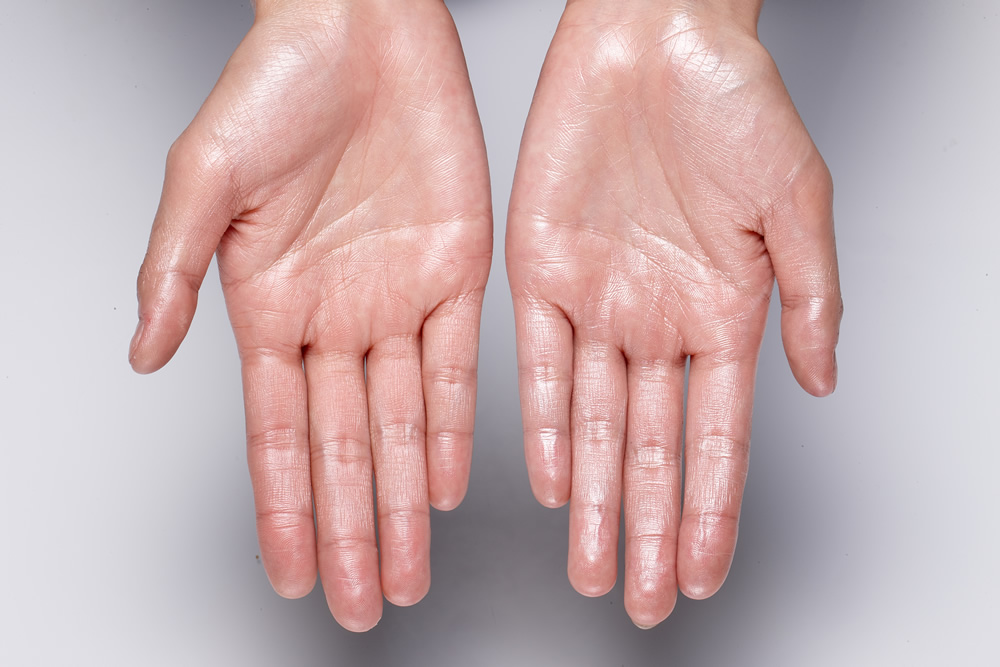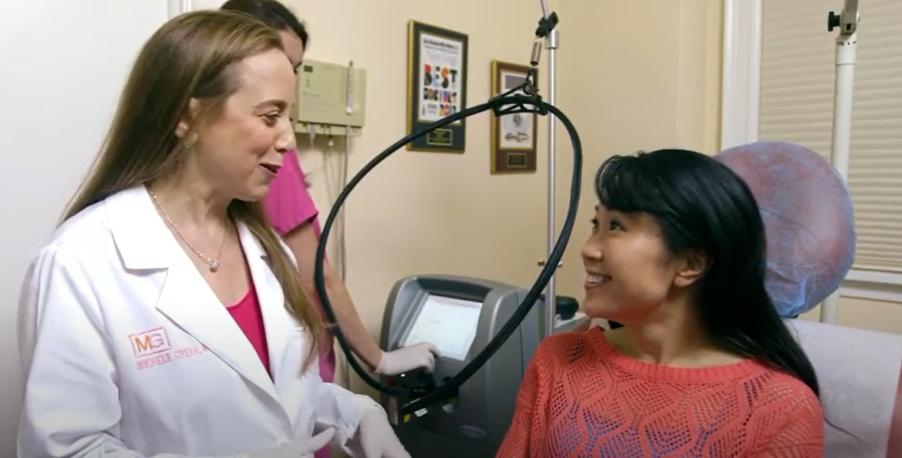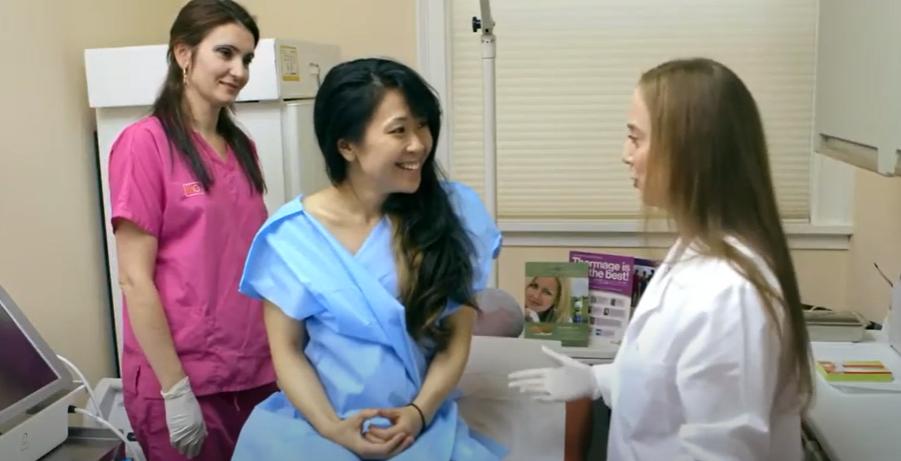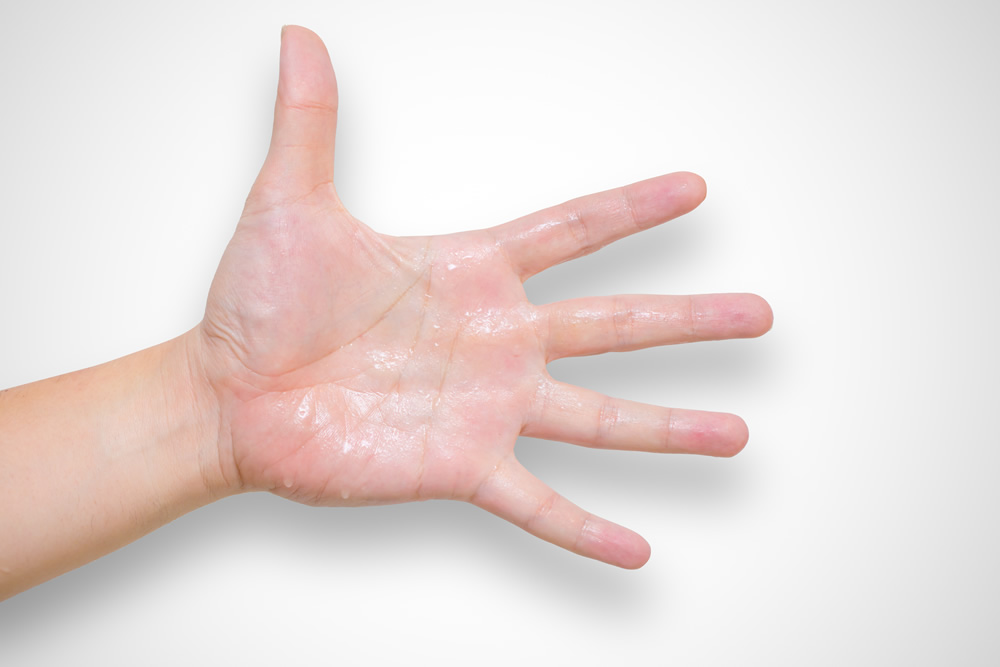Botox for Palmar Hyperhidrosis
Sweating is your body’s natural way to regulate your temperature in a wide range of situations from exercising to finding yourself in a hot environment to responding to stimuli like stress and anxiety. While sweating under these circumstances is completely normal, there are 15 million Americans who suffer from a condition known as hyperhidrosis or excessive sweating. Hyperhidrosis can occur in many areas of the body, but one of the most common places for excessive sweating is the palms of the hands. Palmar hyperhidrosis affects 1 to 3 percent of the population and can greatly impact the way you live your life. Patients experiencing palmar hyperhidrosis may feel self-conscious about shaking hands, struggle to work in social environments or be afraid of handling objects or papers due to sweaty palms. Thankfully, there are many treatment options to safely and effectively reduce excessive sweating of your palms. If you struggle with palmar hyperhidrosis, Dr. Michele Green can help you in her private NYC practice.
One of the most exciting innovations in dermatology is the use of botulinum toxin injections, more commonly known as Botox®, to treat hyperhidrosis. Botox was FDA-approved to treat hyperhidrosis in 2004 and ever since, patients have been thrilled with the results of this treatment. Botox injections are more commonly known for their use in treating wrinkles and maintaining healthy, youthful skin. However, Botox’s role as a safe and effective treatment for hyperhidrosis is on the rise. Model and TV personality Chrissy Teigen has taken to Instagram to discuss how Botox helped treat her hyperhidrosis. If you are experiencing excessive sweating, you are not alone. There are plenty of safe and effective treatment options for treating palmar hyperhidrosis and improving your quality of life.
If you are tired of excessive sweating negatively impacting your life, Dr. Michele Green is here to help. Dr. Green is a board-certified cosmetic dermatologist in NYC with over 25 years of experience. She is consistently voted as one of the best dermatologists in New York by Castle Connolly, New York Magazine, Super Doctors, and the New York Times. She is an expert in treating both axillary and palmar hyperhidrosis and can help improve your quality of life today.

What is Palmar Hyperhidrosis?
Hyperhidrosis is a medical condition in which the body overuses its natural regulatory cooling system, also known as sweat. Our bodies are usually excellent at maintaining a set body temperature but, unfortunately, sometimes the nervous system can over-activate the sweat glands. This results in dysregulation and leads to excessive sweating and discomfort.
Three of the most common forms of hyperhidrosis are axillary hyperhidrosis, palmar hyperhidrosis, and plantar hyperhidrosis. Axillary hyperhidrosis refers to overactive sweat glands in the armpits, which can be exacerbated due to nerves, physical activity, or a hot and humid climate. Plantar hyperhidrosis is defined as overactive sweat glands on the soles of the feet, and it is sometimes coupled with palmar hyperhidrosis, however Dr. Green only treats palmar hyperhidrosis cases currently.
Palmar hyperhidrosis refers specifically to sweaty palms or sweaty hands. It is a common form of hyperhidrosis that typically develops in late adolescence or early adulthood. Most patients realize that they have palmar hyperhidrosis after experiencing an impact on their quality of life, such as difficulty writing due to sweating through paper, or embarrassment when shaking hands. Research is ongoing for palmar hyperhidrosis and hyperhidrosis at large, and Botox injections have become an exciting solution to treat the uncomfortable symptoms of palmar hyperhidrosis.
What causes Palmar Hyperhidrosis?
The most common classification of hyperhidrosis, primary focal hyperhidrosis, is defined by nerves that signal sweat glands too frequently, thus leading to overactive sweat glands and excess sweat. Typically, primary focal hyperhidrosis affects a specific area of the body like the armpits, feet, hands, or forehead and usually worsens with nervousness or stress. Sweating caused by primary focal hyperhidrosis typically occurs symmetrically on each side of the body. Palmar hyperhidrosis is a common part of primary focal hyperhidrosis, which can sometimes be accompanied by sweat on the soles of the feet or the face. Though there is no known cause of primary hyperhidrosis, there is increasing evidence to suggest that there is a genetic component to the condition. More research needs to be done to support this hypothesis but published papers suggest that the development of hyperhidrosis is linked to a dominant gene.
The second type of hyperhidrosis, called secondary generalized hyperhidrosis, is excessive sweating as a result of medical conditions, such as diabetes, nervous system disorders, menopause, certain cancers, and thyroid problems. Secondary generalized hyperhidrosis is characterized by sweating across large areas of the body rather than one specific region. In the case of secondary hyperhidrosis, the primary medical condition should be addressed to eliminate excessive sweating. Additionally, certain medications can be the primary cause of hyperhidrosis. If hyperhidrosis is prompted by the use of a new medication, it is important to disclose this information to Dr. Green when you are discussing your treatment options.

Can you grow out of palmar hyperhidrosis?
Unfortunately, you cannot grow out of palmar hyperhidrosis. In one research survey of nearly 2000 hyperhidrosis patients published in Dermatologic Surgery, 88 percent of respondents of varying age groups said their excessive sweating had gotten worse or stayed the same over time. For the majority of individuals suffering from hyperhidrosis, medical intervention is necessary, especially if you have a family history of hyperhidrosis. Thankfully, there are several available treatment options from prescription-strength antiperspirants, methenamine solution applications to the area, oral anticholinergic medicines, and Botox injections.
Does Palmar Hyperhidrosis go away?
When seeking a cure for hyperhidrosis, it is important to figure out which type you have, as the type of hyperhidrosis determines how the symptoms will go away. If you are suffering from primary focal hyperhidrosis, there is no cure for the condition itself, rather treatment focuses on eliminating the symptoms. Primary focal hyperhidrosis affects specific areas of the body like the underarms, hands, feet, and face and so treatment will be focused on reducing or eliminating sweat in those areas.
Secondary generalized hyperhidrosis, on the other hand, is caused by an underlying medical condition such as diabetes, leukemia, anxiety/stress, hormonal fluctuations, or an infectious disease. Excessive sweating can occur as a side effect of these conditions and if that is the case, it is important to address the health condition for the hyperhidrosis to go away. Secondary generalized hyperhidrosis can also occur as a side effect of the medication that you are taking. If you are finding that is the case, you can consult with your physician about switching your medication or with Dr. Green about treatment options.
Regardless of the cause, Dr. Green will meet with you to discuss your specific condition and decide which treatment method is right to address your needs. There are many different treatment options ranging from topical antiperspirants to oral medication to other procedures such as Botox. Dr. Green will prescribe these treatments individually or in combination to treat your excessive sweating.
How to Cure Palmar Hyperhidrosis
If you’re wondering how to get rid of palmar hyperhidrosis, there are several treatment options. Common initial treatment of focal hyperhidrosis includes prescription antiperspirants and prescription creams, which are designed to build salt clogs that can stop sweat from reaching the surface. In addition, topical aluminum chloride, nerve blocker-based medications, and anti-depressants can all be used to treat hyperhidrosis. Another treatment for more moderate palmar hyperhidrosis is iontophoresis, which uses a low-intensity electrical current to reduce the amount of sweating in target areas. Though these treatments are successful for some, many patients have inconsistent results, and almost all of these treatments require a considerable amount of upkeep.
In severe cases of palmar hyperhidrosis, patients may choose endoscopic thoracic sympathectomy (ETS), which is an invasive surgical treatment intended to permanently interrupt certain nerve signals to eccrine glands (sweat glands). However, this treatment has severe side effects, including but not limited to: compulsory sweating all over the body, arrhythmia, heat intolerance, and hypotension. Due to these risks, any decision to engage with ETS should be made with extreme caution.
For many patients, the journey to find a solution for palmar hyperhidrosis ends with Botox injections. Botox treatment of palmar hyperhidrosis is an ideal option for those looking for consistent relief of sweaty palms. Current research shows that Botox treatment is 80 to 90 percent effective in relieving the symptoms of palmar hyperhidrosis. Botox can also be combined with other treatments to eliminate excessive sweating from the palms. These combination treatments are typically preferred over more invasive treatment options. When determining which treatment option is right for you, it is important to consult with a board-certified dermatologist like Dr. Michele Green.
How to cure palmar hyperhidrosis naturally
You cannot cure palmar hyperhidrosis naturally but certain DIY treatments can potentially and temporarily help with the condition. One option is to use an antiperspirant that you would normally use for underarm sweating on your palms. This can help reduce wetness and clamminess but given the severity of your hyperhidrosis, an over-the-counter antiperspirant may not be effective. Another option is to use baking soda. Baking soda can be mixed with water to create a paste and will function just like an antiperspirant would. If you have tried DIY home remedies to treat your palmar hyperhidrosis to no avail, you should talk to your doctor to see what your treatment options are. Palmar hyperhidrosis will not go away on its own and medical intervention is the best solution.

Does Botox work for palmar hyperhidrosis?
Yes, Botox is one of the best options for treating palmar hyperhidrosis and is a great alternative if other treatment options have failed to bring about the desired results. Botox, named for botulinum toxin type A, is a neurotoxin that halts the innervation of nerve endings. This process was initially developed by Allergan for use in muscle disorders, and shortly thereafter became popular for cosmetic use in the world of cosmetic dermatology and plastic surgery for treating fine lines and wrinkles. It has since been expanded to treat a range of medical conditions, including palmar hyperhidrosis. It is FDA-approved for the medical treatment of excessive sweating of axillae (armpit) hyperhidrosis but many healthcare professionals have found that it can be used to treat palmar hyperhidrosis just as effectively. Botulinum toxin injections are used to disable the sweat glands. Botox acts by blocking the release of acetylcholine and shuts down the action of the sweat glands at the site of injection. The effects of Botox injections can last from 4 to 6 months, depending on the area being treated, and have been shown to reduce sweating by 80 to 90 percent according to sweathelp.org. It is no wonder why Botox injections are widely recommended by experienced dermatologists and healthcare professionals for the treatment of palmar hyperhidrosis, or palm sweating. Botox is the preferred treatment option of Dr. Green when it comes to treating hyperhidrosis.
Botox treatment of palmar hyperhidrosis is an excellent non-invasive method to provide long-lasting relief from sweaty palms. The procedure itself is quick and relatively painless. Typically, the process requires using a topical numbing cream one hour before injections, and if a patient is particularly sensitive to pain, nerve blockers may be recommended for the duration of the treatment. Generally, 20 to 30 ultra-fine injections are used to place Botox into each palm and can be as quick as 15 minutes in all. As this treatment is an advanced Botox injector technique, you must work with a board-certified medical professional who has experience with Botox injections for hyperhidrosis. Dr. Green is an expert in Botox injections for both cosmetic and medical use, and the safety and satisfaction of her patients are her top priority for any Botox treatment. After treatment, the most common side effects are mild muscle weakness (a looser grip), and occasional bruising. Most patients leave their appointment requiring no downtime. Relief from excessive sweating is usually in full effect one to two weeks following treatment.
The effectiveness of Botox in treating hyperhidrosis has been documented in numerous journals like br j Dermatol, j am acad Dermatol, arch Dermatol, and PubMed. One double-blind clinical study published in the PubMed Neurology section randomized participants to either receive a full dose of Botox or an alternative treatment. The study concluded that Botox injections for the treatment of axillary hyperhidrosis are safe and efficacious. Patients’ satisfaction after the treatment(s) was consistently high and patients noted improvement in quality of life and a reduction in the impact of hyperhidrosis on their life. This makes botulinum toxin therapy a great option for treating hyperhidrosis. You can read the full text on PubMed under ID number 12810503.
How common is Palmar Hyperhidrosis?
Sweating is very normal, and most people will find that their palms get sweaty in a variety of situations like engaging in intense physical exercise, spending time in a very warm environment, or being in a nerve-wracking situation like giving a speech in front of a large group of important people. But for those suffering from palmar hyperhidrosis, severe sweating occurs on the hands and/or palms outside of these normal situations. Excessive sweating can happen when you are just sitting at your desk doing work or in a regular social situation and can cause distress or embarrassment. It does not help that palmar hyperhidrosis is exacerbated in stressful situations. When you’re suffering from this condition, it is easy to feel alone but in reality, millions of Americans deal with hyperhidrosis of the palms of hands. It is estimated that 1 to 3 percent of the population suffers from palmar hyperhidrosis. Sometimes, that lonely, embarrassed feeling can keep people from seeking treatment for the condition. Dr. Green is here to make you feel comfortable throughout the whole hyperhidrosis treatment process and can help your hands feel dryer within 2 to 4 days of receiving Botox treatment.
Who does Botox for hyperhidrosis?
Physicians, physician assistants, nurse practitioners, and registered nurses, can administer Botox injections. However, the best individuals to do Botox for hyperhidrosis are trained, board-certified dermatologists, who have years of experience injecting Botox and have previously worked with patients who suffer from hyperhidrosis. These physicians have specialized training in dermatology and can minimize any adverse side effects. In addition, they are equipped to deal with any adverse side effects you may experience that other healthcare professionals might be unable to address. It would also be best to get Botox done in a board-certified dermatology office as opposed to a MedSpa. In a private dermatology office, such as Dr. Michele Green in NYC, you can rest assured that you are in the best hands.
How long does Botox last for Palmar Hyperhidrosis?
As Botox injections are nonpermanent, the results of Botox for palmar hyperhidrosis are also, unfortunately, temporary. However, many patients find that the relief from excessive sweating thanks to one Botox injection treatment can last upwards of six months. For optimal and continual relief from the symptoms of hyperhidrosis, Dr. Green recommends patients continue with routine Botox injections spaced six months apart.
How many units of Botox for Palmar Hyperhidrosis?
Each patient is unique, which is why Dr. Green will take your specific needs and condition into account before determining the units necessary for treatment. On average, patients require a minimum of 100 units of Botox for a single treatment, in both palms. Depending on the size of one’s palm, 0.1 cc aliquots of Botox are injected in 20 to 30 discreet areas of the hand. The injections are spaced approximately 1 cm apart within the areas that are impacted by hyperhidrosis. After the first treatment is complete, Dr. Green will ask patients to return after two weeks for a follow-up appointment so Dr. Green can check the treatment area and provide any additional injections as needed.
How to inject Botox for Hyperhidrosis
The process for receiving the Botox treatment for palmar hyperhidrosis is simple–the procedure does not take long and there is no downtime required after the process. You will begin by meeting with Dr. Green to discuss your particular condition of primary palmar hyperhidrosis and determine the number of units of Botox necessary for your treatment. To prepare the area before the injections, Dr. Green will prescribe a topical anesthetic or nerve blocks that you should apply one hour before your appointment to reduce the feeling in your hand and minimize pain and discomfort. Then, Dr. Green will inject the botulinum toxin type A (on average 100 units total) in 20 to 30 spots on your palm. The injections serve to block the cholinergic nerve cells’ release of acetylcholine, which is a neurotransmitter responsible for sweat production. The treatment itself does not take long to complete and there is no downtime, meaning you can return to your regular activities right after the procedure. The effects of botulinum toxin should be evident 2 to 4 days following the treatment. About 2 weeks after receiving the Botox treatment, you will schedule a follow-up where Dr. Green will assess the injection site and overall treatment area to see if any touch-ups are necessary. Reduced sweating in your palms can last up to 6 months and the Botox treatment can be repeated for continued dryness.

Is Botox safe for Hyperhidrosis?
Yes! Botox is both safe and effective for treating palmar hyperhidrosis when the treatment is done by an experienced and expert dermatologist like Dr. Green. The procedure itself is relatively painless and there is no downtime necessary following the treatment, meaning you can return to your regular activities immediately. There are very few potential side effects, which include bruising and muscle weakness in the hands. Further, there is very little evidence to support that the treatment leads to compensatory sweating elsewhere in the body. In other words, there is minimal risk that your body will compensate for the lack of sweating in your palms by sweating in other areas of your body. That said, Botox treatment is a very delicate procedure, and the risk of potential side effects decreases significantly if you go through the process with a board-certified dermatologist like Dr. Green as opposed to a nurse at a Spa treatment facility.
Which Botox is the safest?
There are currently four FDA-approved forms of neurotoxins on the market: Botox, Dysport, Jeaveau, and Xeomin. These different formulations all contain botulinum toxin type A and have similar safety levels. They have also been used for “off-label” treatment of hyperhidrosis with great success. Botox, however, is the only Botox that has been FDA-approved to treat axillary (underarm) hyperhidrosis whereas the other formulations have not been cleared to treat any form of hyperhidrosis at all. It is also important to note that Jeaveau is a much newer formulation of Botox and has only been on the market since 2019.
Which Botox is the best for sweat? Which Botox is better for sweaty palms?
There are a few different formulations of Botulinum toxin available on the market and they all work equally well in treating palmar hyperhidrosis. Although they may be slightly different variations, they are still derived from botulinum toxin type A and will work to halt signals to the nerve endings that function to stimulate sweat production.
How much is Botox for palmar hyperhidrosis/sweaty palms?
The cost of Botox for palmar hyperhidrosis will depend on how many units of Botox are needed, the geographic location you choose to get injected in, and the experience of the injector. The amount of Botox needed will vary from person to person, and the needs of each patient. Men typically have larger hands and stronger muscles than women and require more units of Botox per area. While the average number of units necessary is 100 units, patients may require more or less depending on their condition and the size of their hands.
The cost of Botox for palmar hyperhidrosis also depends on geographic location. A medical office in NYC may have a higher cost of living and expenses than other cities or states which will increase the price of Botox. Another important factor is the experience of the injector. A board-certified expert injector will be more expensive than a nurse injector at a MedSpa. It’s important to note that getting the procedure done by an experienced expert, such as Dr. Green, has been shown to greatly reduce the risk of possible side effects of the procedure. Botox to treat palmar hyperhidrosis is a delicate procedure that is best performed by an expert dermatologist like Dr. Green, who has many years of experience performing Botox.
Unfortunately, palmar hyperhidrosis is not covered by insurance since Botox is not an FDA-approved treatment for this medical condition. However, Botox for axillary hyperhidrosis may be covered by insurance, though typically this is dependent on several factors. First, the severity of hyperhidrosis must be determined by a medical professional. Additionally, many patients are required to use at least two other treatment options before receiving coverage for Botox injections for the axillae.
What does Botox do for armpits?
Individuals who suffer from primary focal hyperhidrosis may excessively sweat in more areas than one. Many individuals suffer from both palmar and axillary (armpit) hyperhidrosis. Fortunately, Botox is great for reducing underarm sweating through the same mechanism it uses to reduce sweaty palms. Botox is FDA-approved to treat axillary hyperhidrosis and has been one of the best treatment options when other alternative treatments have failed. Botulinum toxin type A will be injected just under the skin of the armpit to block the release of acetylcholine which is responsible for stimulating excess sweat production. Patients will experience dryness within a matter of days and the results will last around six months.
How do I get started with Botox injections for my hyperhidrosis?
If you suffer from palmar hyperhidrosis or excessive sweating elsewhere, Dr. Michele Green in NYC can offer you immediate relief with Botox injections. Dr. Green was one of the first dermatologists in New York to incorporate Botox in her private Upper East Side New York practice. She has over 25 years of experience and has helped countless people who suffer from hyperhidrosis. To schedule a consultation for Botox injections and eliminate palmar hyperhidrosis or axillary hyperhidrosis please call us today at 212-535-3088 or contact us online. Dr. Michele Green and her staff will help you on your journey to eliminate sweaty hands, palms, or underarms, and live a more comfortable, confident life.
 212-535-3088
212-535-3088